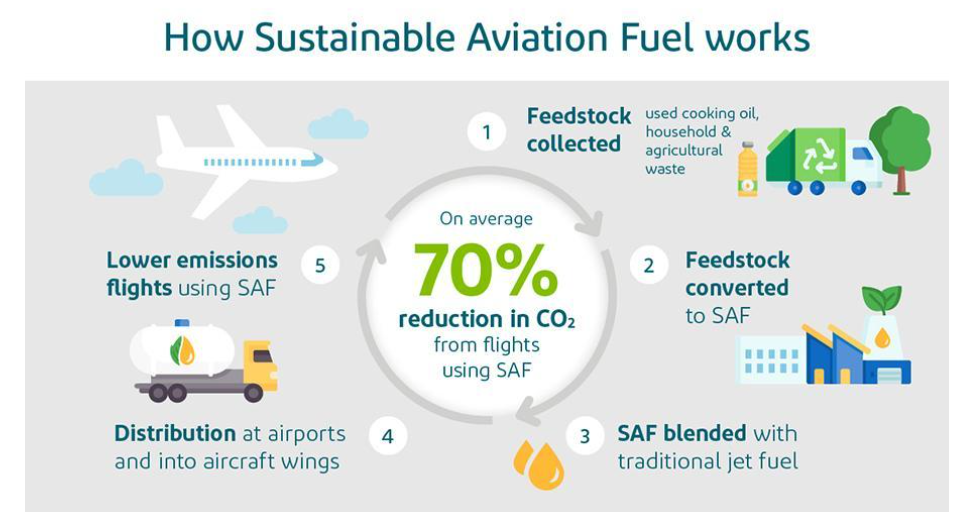Sustainable Aviation Fuel (SAF): The Challenge and Potential
The aviation industry is a crucial driver of global connectivity, but it also faces significant challenges in reducing its environmental footprint. Sustainable Aviation Fuel (SAF) has emerged as a promising solution, offering the potential to drastically cut greenhouse gas emissions without compromising on performance.
This article explores the current landscape of SAF, the challenges it faces, and its immense potential for the future of aviation.
According to the U.S. Department of Energy (DOE),
“Bioenergy Technologies Office (BETO) empowers energy companies and aviation stakeholders by supporting advances in research, development, and demonstration to overcome barriers for widespread deployment of low-carbon sustainable aviation fuel (SAF).”
The DOE goes on to state on their website that they are working with the U.S. Department of Transportation (DOT), the U.S. Department of Agriculture (DOA), and other federal government agencies to develop a comprehensive strategy for scaling up new technologies to produce SAF on a commercial scale.
Tapping Into the Potential of SAF
SAF made from renewable biomass and waste resources have the potential to deliver the performance of petroleum-based jet fuel but with a fraction of its carbon footprint, giving airlines solid footing for decoupling greenhouse gas (GHG) emissions from flight.
The Need for Sustainable Aviation
Commercial aviation accounts for roughly 2.4 percent of global CO2 emissions, and this figure is projected to grow as air travel demand continues to rise. To meet international climate goals and ensure responsible growth, the industry needs a significant shift towards sustainable practices. Here’s where SAF comes in.
What is Sustainable Aviation Fuel?
SAF is a drop-in alternative to conventional jet fuel derived from renewable sources such as used cooking oil, algae, and non-food crops. Unlike fossil fuels, SAF boasts a significantly lower lifecycle carbon footprint, meaning it reduces greenhouse gas emissions throughout its production and use. Studies suggest SAF can achieve reductions of up to 80 percent compared to traditional jet fuel, depending on the feedstock and production pathway.
Benefits of SAF for Aviation
- Reduced Carbon Footprint: The primary benefit of SAF is its ability to drastically cut greenhouse gas emissions from air travel. This directly contributes to achieving net-zero emission goals set by airlines, governments, and international organizations.
- Performance Equivalent: SAF is a “drop-in” fuel, meaning it can be blended seamlessly with conventional jet fuel and used in existing aircraft without modifications. This eliminates the need for infrastructure upgrades or changes in operational procedures.
- Reduced Reliance on Fossil Fuels: Widespread adoption of SAF would decrease the aviation industry’s dependence on fossil fuels, creating a more sustainable and secure energy future.
- Economic Opportunities: The development and production of SAF can create new green jobs and stimulate economic growth in various sectors like agriculture, waste management, and renewable energy.

[Image courtesy of Aer Lingus]
Challenges of Scaling Up SAF Production
Despite its potential, widespread adoption of SAF faces several challenges:
- Limited Production Capacity: Currently, SAF production is limited compared to conventional jet fuel. Reaching ambitious emission reduction targets requires a massive increase in production capacity.
- Higher Cost: Producing SAF is currently more expensive than conventional jet fuel. This price disparity discourages wider adoption by airlines, especially considering the fiercely competitive landscape of the commercial aviation industry.
- Feedstock Sustainability: Ensuring the feedstock used for SAF production is truly sustainable is crucial. Certain sources, like food-based crops, raise concerns about land-use change and potential competition with food production.
- Standardization and Regulations: Standardization of SAF production pathways and clear regulations are necessary to ensure consistent quality and promote investment in the technology.
The Path Forward
Addressing these challenges requires a collaborative effort from various stakeholders:
- Government Support: Governments can incentivize SAF production through tax breaks, subsidies, and carbon pricing mechanisms that make SAF more cost competitive.
- Industry Investment: Increased investment by airlines, fuel producers, and aerospace companies are crucial to expand production capacity and develop efficient SAF production technologies.
- Technological Advancements: Research and development efforts focused on improving existing production pathways and exploring new feedstocks are vital for long-term sustainability and cost reduction.
- Collaboration: Collaboration between airlines, fuel producers, policymakers, and research institutions is essential to address regulatory hurdles, ensure feedstock sustainability, and accelerate the development of the SAF industry.
The Future of Sustainable Aviation
The road to sustainable aviation is paved with challenges, but SAF has the potential to be a significant change. By working together, stakeholders within the industry and beyond can overcome these challenges and unlock the immense potential of SAF. A future where air travel is significantly decarbonized is within reach, paving the way for a more sustainable and environmentally conscious aviation industry.
How Material and Parts Suppliers Can Contribute
As a leading supplier of materials and parts for the aviation industry, AAA Air Support plays a crucial role in promoting the adoption of SAF:
- Partnering with Sustainable Airlines: Collaborate with airlines committed to using SAF and offer them tailored solutions that support their sustainability goals.
- Supporting Research and Development: Partner with research institutions and universities developing innovative SAF production technologies.
- Investing in Sustainable Materials: Explore using sustainable materials in your production processes to minimize the environmental footprint of your own operations.
By embracing sustainability and supporting the development of SAF, your company can also position itself as a leader in the evolving aviation landscape and contribute to a greener future for air travel.
AAA Air Support is a leading supplier and manufacturer of Aerospace Quality Aluminum, Stainless Steel and Titanium Roll Form stringers for the aerospace aircraft maintenance markets. We understand the critical role we play in supporting airlines and manufacturers. And we are committed to providing comprehensive solutions that include:
- Extensive inventory of aircraft parts and materials
- 24/7 customer support and technical expertise
- Streamlined logistics and fast delivery turnaround times
- Collaboration with airlines and manufacturers to develop preventative maintenance strategies
By partnering with AAA Air Support, you can be certain of keeping with global trends and the challenges of a sustainable industry. Contact us today to learn more about what we can do for you and your fleet!

